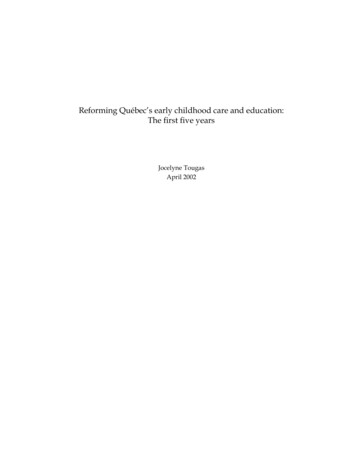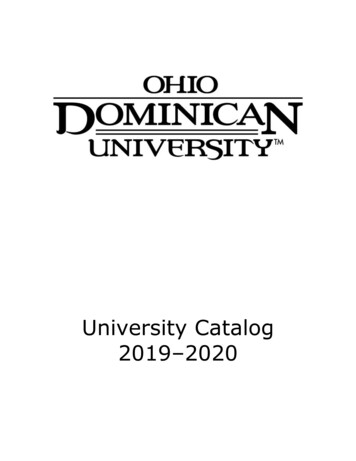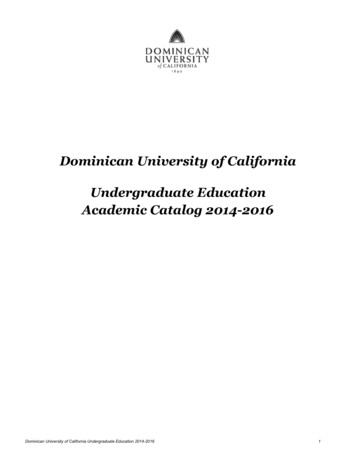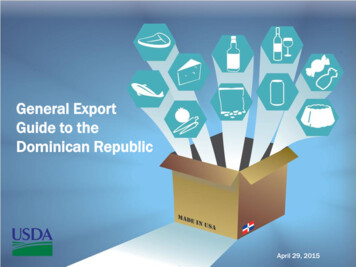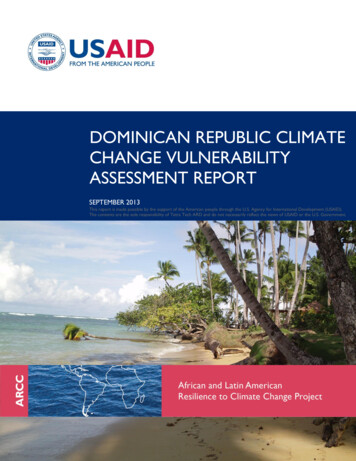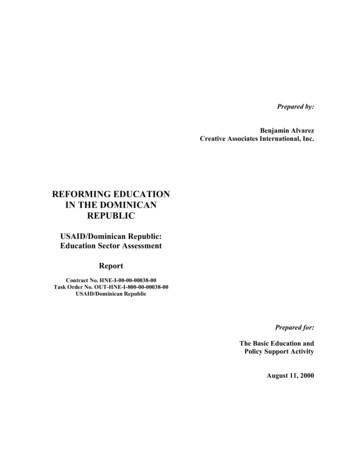
Transcription
Prepared by:Benjamin AlvarezCreative Associates International, Inc.REFORMING EDUCATIONIN THE DOMINICANREPUBLICUSAID/Dominican Republic:Education Sector AssessmentReportContract No. HNE-I-00-00-00038-00Task Order No. OUT-HNE-I-800-00-00038-00USAID/Dominican RepublicPrepared for:The Basic Education andPolicy Support ActivityAugust 11, 2000
USAID/Dominican Republic: Education Sector AssessmentExecutive SummaryIntroductionThis document is a discussion paper addressing the potential role of USAID in the educationof the Dominican Republic, the areas of a potential policy agenda, and possible civil societypartners in the Dominican Republic. The strategy implemented combined diverse elementsdistilled from five parallel, interactive activities: the assessment of the external context ofeducation; identification of unmet needs and challenges for education; the identification ofpolicies issues as perceived by the stakeholders; the assessment of national organizations thatcan play a decisive role in project implementation; and the analysis of the strategies andoutcomes of other reform efforts in other Latin American countries.In completing this assignment, three methods were used. Recent studies and other relevantresearch documents were collected and analyzed. Interviews and group discussions wereheld with decision makers/policy makers in Washington, D.C. and during two field visits tothe Dominican Republic between April and June, 2000.FindingsIn the last decade, educational reform activities have resulted in various educationimprovements, including increased enrollments, a reduced dropout rate, and greater access toeducation for low-income children in the Dominican Republic. Nevertheless, Dominicaneducation still lags behind countries with similar economic conditions, and equity is still achallenge, particularly for children in rural areas. There is still a need to restore civilsociety’s commitment to improving public education, increase public and privateexpenditure, and strengthen the social capital of families and communities to promote theirparticipation in education reform and free the system from the yoke of vested interest groups.Policies are needed to improve teaching and education outcomes, increase equity, strengthenthe education system’s management capacity, ensure accountability, and increase theparticipation of civil society organizations.The findings support that local context, the implementation strategy, the local sense ofownership, and strong, continuous leadership all are important factors in the success ofeducation reform. Universities, research centers, and other institutions of learning can play adecisive role in the sustainability and technical quality of educational reforms by providingimportant information, technical guidance, and evaluation.RecommendationsRather than school construction, teacher training, or curriculum development activities thatcan be supported by loans from international banks, the role of USAID might focus on twoareas: changing the attitudes and behaviors of the major actors in education (e.g.,administrators, teachers, political leaders, families, communities, and students); andgarnering the commitment from diverse sectors (e.g., entrepreneurs, media, and politicians)to ensure transparency in educational system management and public monitoring of itsii
USAID/Dominican Republic: Education Sector Assessmentperformance, and to develop the information required for advocacy. Three levels ofinvolvement are recommended: promoting institutional reform in education through acollective effort of civil society; supporting emerging solutions for educational problems;and helping prepare a new generation of reformers and analysts.\iii
USAID/Dominican Republic: Education Sector AssessmentCONTENTSI.INTRODUCTION.1STRATEGIC NATURE OF THE DOCUMENT.1METHODOLOGY .1ORGANIZATION.3II.EDUCATION IN THE DOMINICAN REPUBLIC, 1990-2000 .5THE CONTEXT: EDUCATION IN THE CHANGING DOMINICAN SOCIETY .5EDUCATIONAL ACHIEVEMENTS OF THE COUNTRY.8UNMET NEEDS AND NEW CHALLENGES FOR DOMINICAN EDUCATION IN THE 21st CENTURY.10POLICY ISSUES CONSIDERED CRITICAL BY STAKEHOLDERS .12III.THE LESSONS OF HISTORY.14NATIONAL CONSENSUS ON EDUCATIONAL REFORM.14SUCCESS FACTORS.15FAILURE FACTORS .15EDUCATIONAL REFORMS OF THE 1990s IN LATIN AMERICA .16THE NEW GENERATION OF REFORMS .17IV.INSTITUTIONAL FRAMEWORK OF EDUCATION.19DEMAND FOR INSTITUTIONAL REFORM .19THE INSTITUTIONAL FRAMEWORK OF EDUCATION.19THE POWER OF INSTITUTIONAL LEARNING.20POTENTIAL ROLE OF THE CIVIL SOCIETY.21V.ORGANIZATIONS OF THE CIVIL SOCIETY AND THE CRITICAL MASS OF REFORMERS .23STRENGTHS OF THE ORGANIZATIONS OF THE CIVIL SOCIETY.23LIMITATIONS .23NETWORKING AND COOPERATION .24MAIN ACTORS.24THE INTERNATIONAL COMMUNITY .25VI.POTENTIAL ROLE FOR USAID.27UNIQUE ROLE FOR USAID .27REASONS FOR INVOLVEMENT IN EDUCATION.27FOCUS AND INVOLVEMENT LEVEL .28A PARTNERSHIP APPROACH .30ASSESSING SUCCESS .31APPENDIX A:APPENDIX B.APPENDIX C:APPENDIX D:APPENDIX E:STATEMENT OF WORK .33BIBLIOGRAPHY .34INDIVIDUAL INTERVIEWS AND MEETINGS .37COMPONENTS OF ECONOMIC GROWTH.41“AUTONOMIA ESCOLAR Y REFORMA EDUCATIVA".42iv
USAID/Dominican Republic: Education Sector ns1. Strategy Architecture . vii2. Children and Youth As % of Total Population, 1995-2020 33. Public Investment in Education As % of GNP 44. Children and Youth Enrollment in School . 54. Educational Attainment of Dominican Children . 65. Third Grade Language Achievement Scores 8TablesTable 1: Policy Issues Considered Critical 9Table 2 International Community Education Activities .20v
I.INTRODUCTIONSTRATEGIC NATURE OF THE DOCUMENTThis document is a discussion paper addressing the potential role of USAID in the educationof the Dominican Republic, the areas of a potential policy agenda, and possible partners ofthe civil society in Dominican Republic. (Specific responsibilities are provided in the Scopeof Work in Appendix A.) The proposed strategy was built by combining diverse elementsresulting from five parallel and interactive processes, as presented in illustration 1(Architecture Strategy): Assessment of the external context of education that provided the foundation forsubsequent analyses;Identification of unmet needs and challenges for education;Identification of policy issues as perceived by the stakeholders;1Assessment of national organizations that can play a decisive role in the implementationof the strategy, andAnalysis of the role of other international actors.METHODOLOGYThe methodology, which followed what was established in the work plan of the Scope ofWork, consisted of three main activities: analysis of recent studies; interviews with variousstakeholders in the Dominican Republic; and group discussions with appropriate people inthe Dominican Republic and Washington, DC.Studies that were analyzed related to the recent development of the Dominican Republic, theevolution of education in the country over the last decade, and the impact of educationreforms in the country and in Latin America in general (papers and documents collected andreviewed are listed in Appendix B, Bibliography). Given the scope and time of the project, itwas not possible to collect original primary statistical and historical data. The consultanttherefore had to rely on secondary data and analyses conducted by other organizations (suchas the World Bank, the Inter-American Development Bank, and PREAL) to obtain apanorama of the education achievements and challenges in the Dominican Republic. Severaldocuments referred to current education problems and reform strategies in other countries,particularly in Latin America and the Caribbean. The consultant considers this knowledgecritical for developing an educational strategy in the Dominican Republic.1By stakeholders we mean people with expertise and interest in education that can provide help to thedevelopment of an educational strategy. Stakeholders were not selected using statistical sampling techniques;rather, together with USAID/Dominican Republic, the consultant identified people with relevant experience andknowledge among educators, entrepreneurs, officers of foundations and international banks, the teachers union,and private citizens.
USAID/Dominican Republic: Education Sector AssessmentInterviews were conducted with entrepreneurs, social scientists, university professors,officers of the international banks, school teachers, and members of the teachers union (Seelist in Appendix C).2 USAID's mission in the Dominican Republic provided invaluableassistance in the selection of interviews and intellectual support. In a first meeting withmembers of USAID's mission, an agreement was reached on the methodological approach(interviews with different people involved in education), and a first list was prepared. Groupdiscussions were conducted with USAID’s experts in Washington, the Dominican Republic,and other Latin American countries, with members of Creative Associates International,Inc.,3and with Dominican teachers and graduate students that were specializing in publicpolicies.4In accordance with the terms of reference of the project, the author visited the DominicanRepublic on two occasions. The visits had several purposes:a) to meet with USAID Mission staff in Santo Domingo, the main users of the proposedfinal document (the role of the consultant was conceived as an assistant for the Mission(See page 2 of the Scope of Work);b) to help the Mission to assess institutions and possible partners for USAID's educationalagenda in the Dominican Republic;c) to help the Mission to identify strategies to pursue to incorporate the business sector as ateam player that can contribute to the sustainability of advocacy projects;d) to understand what are critical education policy issues as perceived by Dominicans (inthe public, private, and academic sectors) interested in educational reform; ande) to understand the agenda and activities of USAID in the country.During the first visit, from April 24– May 10, 2000, the consultant met with members of theUSAID/Dominican Republic staff to discuss approach, work methodology, and a list ofpeople to interview. Meetings were arranged, the first series of interviews were conductedin Santo Domingo and Santiago de los Caballeros, and documents prepared in theDominican Republic were collected. This visit concluded, as suggested by the Scope ofWork, with another meeting in USAID's Mission to discuss first findings and the outline ofthe report. There was another meeting in Washington with USAID staff to discuss the2Since there were not specific hypotheses to test and the purpose of the interviews was to provoke new ideas,the sessions were rather open, but focused on three main areas: a) critical problems of basic education in theDominican Republic; b) policy issues; and c) the potential role of civil society. In a second visit, thecharacteristics of a possible USAID strategy also were discussed.3One session at USAID in Washington, and several discussions with members of the staff of CreativeAssociates International, Inc. were held.4One excellent opportunity for learning about new thinking was a discussion session on educational reformwith graduate students and professors of the Design and Management of Social Policies Program of the InterAmerican Institute of Social Development (IDB) and the Universidad INTEC.2
USAID/Dominican Republic: Education Sector Assessmentprocess followed and the report outline. Once the first draft was prepared and sent, andsome comments were received from USAID/Dominican Republic.A second trip to the Dominican Republic, June 19-27, 2000, included a visit to the USAIDMission and interviews arranged by the Mission, as well as others. As suggested by theMission, the consultant participated in the seminar of EDUCA's consultants, who arepreparing a new strategy for the organization. Although the second visit was shortenedbecause of health reasons, it also concluded with a meeting with the responsible USAIDProgram Officer. The list of interviews in both visits is in Appendix C (names of people metduring the second trip have a number 2 in parentheses).A third version of the document was circulated for comments in USAID's Mission in theDominican Republic and Washington. This final version integrates the comments providedby the Mission in Santo Domingo.This document presents complementary lines of support for education by USAID in theDominican Republic as bases for the development of further plans of action. Note, however,that it is not yet a specific plan of action.ORGANIZATIONThe paper is organized according to a series of questions within each of its five remainingsections. Section II discusses the role of education in the economic and human developmentof the country and the critical challenges faced. Section III derives some lessons from recenteducational reform efforts in the Dominican Republic and some other countries of the region.Sections IV and V focus on required institutional changes and the role and possibilities of thecivil organizations and their leaders to promote those reforms. The final section,Recommendations, proposes a role for USAID, describes the nature of such a role, andconsiders potential partners and assessment issues.3
USAID/Dominican Republic: Education Sector AssessmentILLUSTRATION 1: STRATEGY ARCHITECTURELevel 3Level 2Level 1Unique Role of USAIDIdentification of Unmet NeedsAssessment ofNationalActorson of Unmet NeedsStakeholder Perception ofIdentificatiPolicy IssuesInternationalActorsContext Assessment4
USAID/Dominican Republic: Education Sector AssessmentII.EDUCATION IN THE DOMINICAN REPUBLIC, 1990-2000This section analyzes briefly the development of education in the Dominican Republic (DR)as a contextual background for assessing what may be the potential contribution of USAID toDominican education in the immediate future. The section answers three main questions: Why is education critical for the DR?What have been the achievements of education in the DR over the last decade?What are the main national educational challenges for the next decade?THE CONTEXT: EDUCATION IN THE CHANGING DOMINICAN SOCIETYProfound external transformations and internal evolutions are changing the DominicanRepublic society. Education is the key for the country to respond to the demands emergingfrom those new conditions.From an economic model based on the exportation of few agriculture products and an in ward-oriented approach, the country is moving towards an open market economy with fastgrowing activity in areas such as tourism, manufacturing, telecommunications, andconstruction. There is a growing awareness among entrepreneurs about the need to raise theeducational attainment of the workforce as a basic requirement for a competitiveenvironment that will allow the Dominican economy to succeed. Increasing the quality ofthe higher cycle of basic education5 and coverage of secondary education will be critical forthe current generation of young Dominicans to benefit from this economic growth and helpto sustain it. The limitations of the Dominican educational system are reflected in thecontinuous decrease of productivity indicators over the last two decades as shown inAppendix D.In rural areas especially, a different development model still persists. Slow economic andsocial progress and enduring poverty and ignorance characterize this model. Living in a ruralarea has a negative impact on the probability of attending school.6 The main source ofincome for the poor is employment, with remittances from USA being mostly a middle-classphenomenon.7 Education is an important tool for preparing poor people for better qualitywork, and ultimately for reducing poverty.After a long history of authoritarian regimes, the Dominican Republic is entering a new eraof democracy and social participation. Past presidential elections, however, havedemonstrated the decisive role that traditional “caudillismo” still plays in the political life ofthe country. Educated voters have better capabilities for establishing institutions andtransparent regulations that are able to monitor the work of public officers, the essence of ademocratic regime.5Basic education of nine years includes a cycle of three years equivalent to lower secondary.World Bank 1998.7According to World Bank estimates, remittances from abroad account only for 2 percent of total income of thepoor in the Dominican Republic.65
USAID/Dominican Republic: Education Sector AssessmentA less visible, but very important, transformation for education is the evolution of thedemographic profile of the Dominican Republic. The proportion of children in the overallpopulation is shrinking (see Illustration 2). The vast majority of the population is of workingage (15-64 years old).8 This presents an opportunity for raising living standards, if thoseworkers are well prepared for the global economy. Since the juvenile population will besmaller, past emphasis on school access may be shifted to school improvement and to thecontribution of education to business and industry and citizen participation in civil societythrough innovations and qualitative changes.9Unfortunately, institutions, organizations, and human resources in the country have notdeveloped at the necessary pace to respond to the requirements of the new internal andexternal contexts. Therefore, these changes are happening in an environment ofcharacterized by limited enforcement of the educational law, insufficient institutionaldevelopment, and poor educational conditions.Education reflects several of the contradictions of the country. One of the fastest growingeconomies of the world— with an average growth of 7.5 percent over the last three years—the Dominican Republic has one of the lowest investments in education of the hemisphere.10Although public investment in education has increased in the last decade (see Illustration 3),it is still very low in comparison with other Latin American countries. Venezuela, forexample, invests 4.1 percent of its GNP in education, Chile invests 3.7 percent; and Panamainvests 5.5 percent, whereas the Dominican Republic allocates only 2.1 percent.11Paradoxically, many Dominicans continue to live in poverty and, hindered by lack ofeducation and limited physical assets, are unlikely to improve their personal situation even asthe national economy experiences a period of relatively high economic growth in comparisonwith other Latin American countries.8The growth of Dominican population ages 0-14, 15-64 and 63 can be consulted ocall.htm9An additional population issue that has not been addressed in education is the growing number of immigrantsfrom Haiti (some estimate this population is approximately one million people). Although unaccounted for inthe official statistics, this population should be considered.10According to the World Bank, IDB estimates a growth of 6 percent since 1992, which, while lower than the7.5 percent, is still very high. It is difficult, however, to identify all of the contributors to this fast growth.11The Law establishes that 4 percent of the GNP should be invested in education.6
USAID/Dominican Republic: Education Sector AssessmentILLUSTRATION 2Percentage of Total PopulationChildren and Youth as Percentage of Total Population in DominicanRepublic1995-202018%16%14%12%10%0- : World Bank, 2000.One of the most participatory educational reform processes of Latin America initiated at thebeginning of the decade in the Dominican Republic was not able to change the persistentlycentralized and slow decision-making mechanisms of the Secretary of Education. The legacyof past dictatorships still shapes both the formal and the informal rules of public behavior-the institutions of the country.12The contribution of education to sustained economic growth, poverty reduction, anddemocracy in the country is today more critical than ever before. Education provides humanresources for a competitive environment, a more equitable distribution of knowledge andincome, and the social capital for social participation, essential for policy r
Dominican Republic as bases for the development of further plans of action. Note, however, that it is not yet a specific plan of action. ORGANIZATION The paper is organized according to a series of questions within each of its five remaining sections. Section II discusses the role of education in the economic and human development


